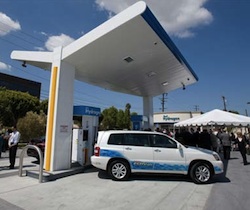 A new report, “Projected Outlook for Next Generation and Alternative Transportation Fuels in California 2010-2030,” has been released. The report concludes that with current investments and advances in alternative fuels over the past several years should lead to a significant displacement of petroleum-based fuels like diesel and gasoline. The report was released by Fueling California and Orange County Business Council and was authored by research experts at University of California, Irvine, the Automotive Club of Southern California and Tiax, LLC.
A new report, “Projected Outlook for Next Generation and Alternative Transportation Fuels in California 2010-2030,” has been released. The report concludes that with current investments and advances in alternative fuels over the past several years should lead to a significant displacement of petroleum-based fuels like diesel and gasoline. The report was released by Fueling California and Orange County Business Council and was authored by research experts at University of California, Irvine, the Automotive Club of Southern California and Tiax, LLC.
“Historically, California has been a trend-setter for the rest of the world in the transportation and fuel sectors,” said Mr. Sturtz. “California represents one of the largest fuel markets in the world and also houses some of the most technically innovative people, research institutions, and businesses to create an environment that incubates innovative and next-generation technologies. “These market factors coupled with a unique set of state government regulations that are creating a push for alternative fuels points to a large market that could potentially provide commercial benefits to all components of the fuel supply chain.”
While the report suggests a reduction of fossil-fuel based transportation fuels, because it takes between 10-15 years to change a fleet, by 2030 at least 75 percent of the fuels used will still remain petroleum-based. The report discusses three principal drivers for development of alternative fuels worldwide: reducing greenhouse gases, energy security, and urban air pollution. The report also discusses state policies, socio-economic factors, market forces, and business environment in California.
 “Alternative fuels are currently receiving a lot of attention in business, media and politics,” said Shane Stephens-Romero with the Advanced Power and Energy Program at UC Irvine, primary author of the study. “With so much focus on the topic, this report fulfills an important need by providing an information resource that is anchored in the real market, technical, environment, and policy levers that are shaping the alternative fuel landscape.”
“Alternative fuels are currently receiving a lot of attention in business, media and politics,” said Shane Stephens-Romero with the Advanced Power and Energy Program at UC Irvine, primary author of the study. “With so much focus on the topic, this report fulfills an important need by providing an information resource that is anchored in the real market, technical, environment, and policy levers that are shaping the alternative fuel landscape.”
The report projects that petroleum, gasoline and diesel, which in 2010 fueled 94 percent of California’s light duty vehicles and 98.7 percent of the state’s heavy duty vehicles, will still be required for 79 percent of light duty vehicles and 76.7 percent of heavy duty vehicles in 2030.
In the heavy-duty sector, biodiesel and renewable diesel are projected to have the biggest jump although natural gas is expected to play a significant role. The fuel mix will also include ethanol, hydrogen and electric plug-in vehicles. In the light-duty vehicle sector, the biggest increase is projected for hydrogen, yet ethanol is projected to be the largest contributor to the alternative fuel mix with blending in gasoline going as high as 15 percent. Regardless, the report suggests that the majority of this sector will move to electrification of the drive train with fuel cell electric and plug-in electric vehicles playing an increasingly significant role between now and 2030. Finally, the report concludes that biojet fuel will need to overcome several technical and commercial challenges before they become commonplace.

